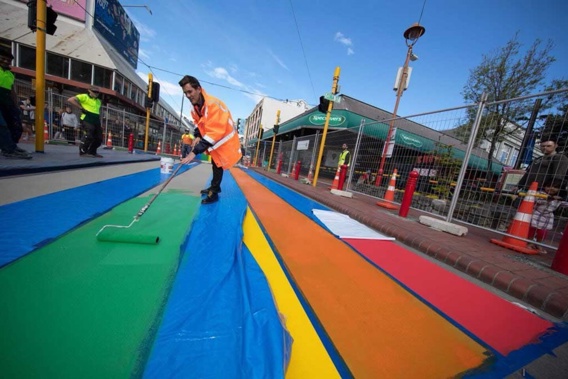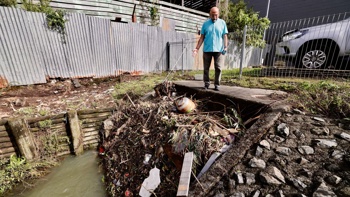
- Wellington’s Cuba St rainbow crossing was painted in October 2018 to make the capital “more deliberately LGBTQI-friendly”.
- A judicial review hearing is taking place at the High Court today, questioning the crossing’s legality.
- Those behind the action say they don’t want the crossing removed, just changed to comply with the law.
Wellington’s rainbow crossing on Cuba St is being challenged in court with questions raised about how safe it is and whether it’s legal.
Avataeao Ulu and four others are seeking a judicial review in the High Court at Wellington over whether the crossing complies with the law.
They say the review is not about diversity and they don’t want the crossing removed, just for it to abide by the rules.
The Cuba St rainbow crossing was painted in October 2018, after Wellington City Council signed off on the idea in a quest for the capital to be “more deliberately LGBTQI-friendly”.
Ulu’s lawyer Mai Chen opened her client’s case by outlining what the case was and wasn’t about.
Chen said the review was not about the very important issue of diversity, but when to express that and where it’s put.
“What this case is not about is the importance, the soundness, the value of the celebration of diversity ... the only issue here is whether what happened in this case compromised road safety and contravened the requirements of safety legislation. That is what this case is about.”
She said the case was about Wellington City Council’s failure to comply with the land transport rule and the transport agency’s failure to enforce it.

The rainbow crossing was a key project for former mayor Justin Lester. Photo / @justin_lester
Chen said it was about the safety of all road users including motorists, pedestrians and cyclists.
She said the council had decided to communicate the important message of diversity where there were traffic lights, with road markings that resembled a pedestrian crossing in a pedestrian mall.
“All I’m saying is the message is important but why did they have to put it here.”
She said 2000 cars a week travelled over the crossing at more than 30km/h and 170 cars travelled at over 60k/h. Some reached speeds of 120km/h.
Chen told the court research showed that if a car travelling at 30km/h hit a pedestrian they had a good chance of survival whereas if they were hit at 60km/h they had virtually no chance of survival.
While there had been no fatalities at the crossing, she pointed to the recent incident in Martinborough, where a four-seater bike collided with a car, killing one.
Chen referred to the NZTA’s submission that the issue was not about the setting of speed limits, but whether there was a lower risk environment to allow for roadway art, even though it didn’t have a traffic purpose.
She said the council’s correspondence showed the mayor at the time (Justin Lester) wanted it and council staff delivered it.
Chen said she wasn’t asking the council to remove the crossing, just to change it to ensure it complied with the rules.
Lawyers for the transport agency and council are due to respond to Chen’s arguments this afternoon.
Catherine Hutton is an Open Justice reporter, based in Wellington. She has worked as a journalist for 20 years, including at the Waikato Times and RNZ. Most recently she was working as a media adviser at the Ministry of Justice.

Take your Radio, Podcasts and Music with you









